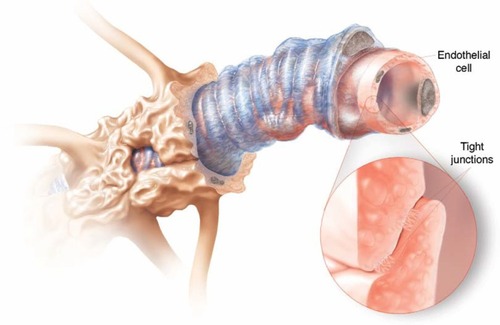To the editor
In a recent report published in the International Journal of Nanomedicine, Gulati et alCitation1 have described the most innovative study addressing an important issue of the “blood–brain barrier,” which can act as a barrier to one of the fundamental goals of modern neurobiology that would have a direct impact on highly debated future therapeutics for both brain cancer and neurological disorders. Contrary to what has been the case with conventional therapy, the authors were able to completely bypass the blood–brain barrier () – a limiting factor for efficient drug delivery – by proposing a new, alternative approach using nanoengineered TNT/Ti implants for local delivery of chemotherapeutics such as doxorubicin into the brain. There must be millions of good drugs sitting in pharmaceutical company stores that cannot be delivered simply because they cannot get past the blood–brain barrier.Citation2 This is an area that has been under-researched and its significance has not yet been recognized. Neuroscience textbooks bury this issue in the appendix, PhD programs give it a cursory treatment, and pharmaceutical companies have tried to ignore it. Despite the blood–brain barrier acting as a stubbornly real obstacle for potential drugs to be used against many disorders of the central nervous system, the field of drug delivery is advancing rapidly. Recently, for example, systemic injection with iRGD improved the therapeutic index of drugs of various compositions including doxorubicin, nanoparticles (nab-paclitaxel and doxorubicin liposomes), and a monoclonal antibody (trastuzumab).Citation3
Figure 1 Tight security. Brain capillaries are surrounded by different types of cells, but the real barriers are the tight junctions between endothelial cells in the capillary lining.Citation2 From Greg Miller, SCIENCE 297:1116 (2002). Illustration: Cameron Slayden. Reprinted with permission from AAAS. Available from: http://www.sciencemag.org/content/297/5584/1116.summary.

Although the researchers were looking for another entryway into the brain, the study succeeded in providing evidence for controllable drug-releasing characteristics, a hallmark feature of modified Ti wires with several clinical and pharmacological advantages over currently existing methods that can prove to be very interesting. However, no evidence-based information about the possible limitations and the applicability of these implants in vivo is available.
In summary, regarding how to attain maximum patient benefits through any potential drug delivery, the use of nanoengineered TNT/Ti implants is obviously an invasive approach that requires microsurgery within the brain, which is a highly complicated part of the body. However, poor penetration of anticancer drugs into the blood–brain barrier is an important factor limiting the efficacy of these medications in reaching a number of tumors. Academic researchers have recently been compelled to search for alternative ways to overcome these limitations, yet safe and effective anticancer therapies are but a dream.
We appreciate the kind comments from Dr FA Shiekh and his evaluation of our recent paper on nano-engineered drug-releasing Ti wires as an alternative for local delivery of chemotherapeutics in brain.Citation1 We enjoyed reading his comments and are pleased to hear his appreciation for new approaches outside conventional drug therapy aiming to address blood–brain barrier issues, certainly one of the most important problems in modern neurobiology. Nanotechnology approaches certainly offer considerable potential for designing new drug delivery systems and exciting developments will come in the near future. Nano-engineered drug-releasing devices for local drug delivery based on titania nanotube (TNT) arrays are a promising example that provide several advantages, which we highlighted in our paper.
In our work we presented initial in vitro studies using two model drugs, relevant CNS, and brain therapy to demonstrate the potential application of TNT/Ti wires as drug-releasing implants, and we also noted that extensive in vivo investigations are necessary in the future to prove the performance of these implants. Although we didn’t provide direct experimental evidence, previous studies successfully demonstrated the application and biocompatibility of TNT/Ti in animalsCitation2 and in vivo conditions.Citation3 In our recent work (Aw et al, unpublished data, 2012) using an ex vivo bone model, we developed a method to measure drug release kinetics from TNT/Ti wire inserted inside bone and to monitor drug distribution in bone. We propose that TNT/Ti wire implants could be inserted via a microsurgery inside or close to the target area of the brain where treatment is required. The invasiveness of TNT/Ti wire implants remains a disadvantage, even though the implantation of thin wires (0.5 mm diameter) is less invasive in comparison with other brain implants (polymer discs, 2 cm diameter). However, this limitation can only be addressed once in vivo studies have been performed. Nevertheless, we believe the potential benefits of this system for providing localized therapeutic effectiveness and bypassing the blood–brain barrier without systemic drug distribution is significant.
References
- GulatiKAwMSLosicDNanoengineered drug-releasing Ti wires as an alternative for delivery of chemotherapeutics in the brainInt J Nanomedicine201272069207622619543
- von WilmowskyCBauerSLutzRIn vivo evaluation of anodic TiO2 nanotubes: an experimental study in the pigJ Biomed Mater Res B Appl Biomater20098916517118780361
- SmithBSYoriyaSGrissomLGrimesCAPopatKCHemocompatibility of titania nanotube arraysJ Biomed Mater Res A201196608